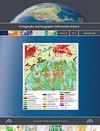在金字塔模型框架中分析多尺度空间点模式
IF 2.4
3区 地球科学
Q1 GEOGRAPHY
Cartography and Geographic Information Science
Pub Date : 2022-04-01
DOI:10.1080/15230406.2022.2048419
引用次数: 1
摘要
摘要许多空间分析方法都存在可修改面积单元问题(MAUP)中的缩放问题。本文介绍了金字塔模型(PM),这是一种在三维环境中集成空间和空间尺度的分层数据框架,用于支持多尺度分析。PM在检验象限密度和核密度方面的效用得到了检验,这是点模式的常用度量。PM中表示了从具有不同标度参数(即象限和带宽)的模拟点集计算的两个度量。PM允许检查在所有不同标度下计算的密度度量的变化。3D可视化技术(例如体积显示、等值面和切片)允许用户观察不同尺度的空间模式之间的嵌套关系,并理解空间分析中的缩放问题和MAUP。开发了一种具有交互式控制的工具,以支持对PM中内部模式的视觉探索。除了点模式测量外,PM还具有分析其他空间指标的潜力,如空间自相关指标、回归分析系数和空间模型的准确性测量。PM的实施进一步推动了时空分析多尺度框架的发展。本文章由计算机程序翻译,如有差异,请以英文原文为准。
Analyzing multi-scale spatial point patterns in a pyramid modeling framework
ABSTRACT Many spatial analysis methods suffer from the scaling issue identified as part of the Modifiable Areal Unit Problem (MAUP). This article introduces the Pyramid Model (PM), a hierarchical data framework integrating space and spatial scale in a 3D environment to support multi-scale analysis. The utility of the PM is tested in examining quadrat density and kernel density, which are commonly used measures of point patterns. The two metrics computed from a simulated point set with varying scaling parameters (i.e. quadrats and bandwidths) are represented in the PM. The PM permits examination of the variation of the density metrics computed at all different scales. 3D visualization techniques (e.g. volume display, isosurfaces, and slicing) allow users to observe nested relations between spatial patterns at different scales and understand the scaling issue and MAUP in spatial analysis. A tool with interactive controls is developed to support visual exploration of the internal patterns in the PM. In addition to the point pattern measures, the PM has potential in analyzing other spatial indices, such as spatial autocorrelation indicators, coefficients of regression analysis and accuracy measures of spatial models. The implementation of the PM further advances the development of a multi-scale framework for spatio-temporal analysis.
求助全文
通过发布文献求助,成功后即可免费获取论文全文。
去求助
来源期刊
CiteScore
5.20
自引率
20.00%
发文量
23
期刊介绍:
Cartography and Geographic Information Science (CaGIS) is the official publication of the Cartography and Geographic Information Society (CaGIS), a member organization of the American Congress on Surveying and Mapping (ACSM). The Cartography and Geographic Information Society supports research, education, and practices that improve the understanding, creation, analysis, and use of maps and geographic information. The society serves as a forum for the exchange of original concepts, techniques, approaches, and experiences by those who design, implement, and use geospatial technologies through the publication of authoritative articles and international papers.

 求助内容:
求助内容: 应助结果提醒方式:
应助结果提醒方式:


